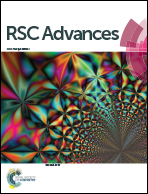An organic–inorganic nanohybrid of a calix[4]arene based chromogenic chemosensor for simultaneous estimation of ADP and NADH†
Abstract
The versatility in the environmental and biological applications of nanohybrids encouraged us to prepare a novel chemosensor based on an organic–inorganic nanohybrid (H1) employing receptor 1 (R1), which was synthesized via the Schiff’s base condensation reaction of a calix[4]arene derivative and an aliphatic amine. Techniques such as DLS and TEM were employed for the characterization of organic nanoparticles (N1) and H1. Further, sensor properties of H1 were explored towards various biologically important molecules in aqueous media using UV-visible spectroscopy. The proposed sensor responded effectively for the selective and simultaneous nanomolar determination of adenosine diphosphate (ADP) and reduced nicotiniamide adenine dinucleotide (NADH). The response was not affected by the presence of each analyte or any other potentially interfering biomolecule or a high concentration of salt. The proposed sensor was also found to show a stable response in an extensive pH range thus widening its practical applicability. H1 was able to detect a minimum concentration (detection limit) of 6.11 × 10−9 M of ADP and 4.87 × 10−9 M of NADH. The prepared hybrid was subjected to real sample analysis for the determination of ADP and NADH in samples prepared artificially by adding known concentrations of NADH and ADP in solution and also in a mixture of both.
![Graphical abstract: An organic–inorganic nanohybrid of a calix[4]arene based chromogenic chemosensor for simultaneous estimation of ADP and NADH](/en/Image/Get?imageInfo.ImageType=GA&imageInfo.ImageIdentifier.ManuscriptID=C5RA18003A&imageInfo.ImageIdentifier.Year=2015)

 Please wait while we load your content...
Please wait while we load your content...